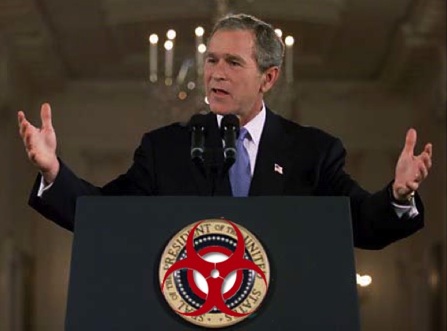
Much of the University of Texas medical school on this island suffered flood damage during Hurricane Ike in September, except for one gleaming new building, a national biological defense laboratory that will soon house some of the most deadly diseases in the world.
How a laboratory where scientists plan to study viruses like Ebola and Marburg ended up on a barrier island where hurricanes regularly wreak havoc puzzles some environmentalists and community leaders.
“It’s crazy, in my mind,” said Jim Blackburn, an environmental lawyer in Houston. “I just find an amazing willingness among the people on the Texas coast to accept risks that a lot of people in the country would not accept.”
Words like “gullible” and “ignorant” come to mind.
The project enjoyed the strong support of three influential Texas Republicans: President George W. Bush, a former Texas governor; Senator Kay Bailey Hutchison; and the former House majority leader, Tom DeLay, whose district includes part of Galveston County. Officials at the National Institutes of Health, however, say the decision to put the lab here was based purely on the merits. It is to open Nov. 11.
The laboratory is one of two the Bush administration pushed after the Sept. 11, 2001, terrorist attacks. The second is being built at Boston University Medical Center, where it met stiff community resistance.
Not so in Texas, where there was hardly a whimper of protest. For starters, the University of Texas Medical Branch is one of the largest employers on the island of 57,000 people.
The laboratory will do research into diseases like Ebola, anthrax, tularemia, West Nile virus, drug-resistant tuberculosis, bubonic plague, avian influenza and typhus.
Does Texas “deserve” this facility? Is this really a “reward” for Republican loyalty?















#31 FTW
The Tacoma Narrows Bridge was built to the standards of the day. In fact, they used most of the same engineering and design firms that were used on the Golden Gate Bridge constructed just a few years earlier.
What was learned was that the Tacoma Narrows Bridge was narrower (2 lanes) and lighter than the Golden Gate. The wind also sometimes blew exceeding hard down the narrows, higher than in San Fransisco Bay. The guard rail were much more wind stopping and acted as a sail. These four factors made the bridge much more prone to sympathetic vibration than previous suspension bridges.
What was learned? Don’t build the span to capture the wind, allow the wind to flow over and under the span, and wider is better. It is too bad it took an expensive bridge to learn those lessons. On the good side is no one was injured.
So what lessons can we learn here? Pork can sometimes give you food poisoning. The second might be “don’t tempt fate”.
Well said, my thermonuclear friend.
Would a true athiest give shit about tepmting fate. I find you lack of anti-faith disturbing.
I, due to my belief in cosmic justice, might believe that if I die due to some boneheaded mistake, that the culprits will find justice eventually. An atheist doesn’t have that assurance, so I might argue that gives them more reason to be safety conscious, not less.
Is this perhaps a subtle form of Democratic Congressional revenge on Texas for supporting Bush?
#36 Li, Interesting that you think your life is at some one elses mercy, specifically the dark overlords known as the boneheaded culprits. It’s also interesting that you think cosmic justice will avenge what YOU think is injustice.
Exactly whose safety would the athiest have in mind, yours?